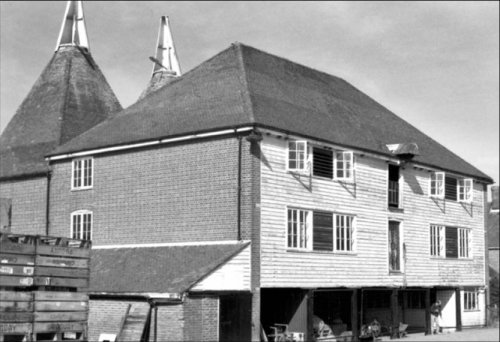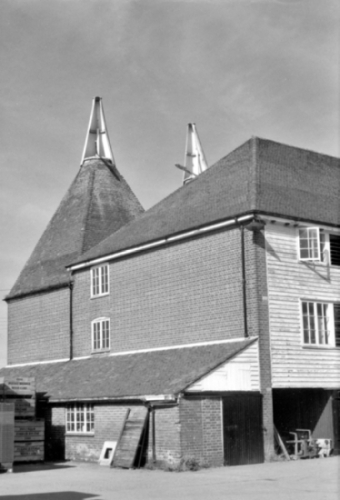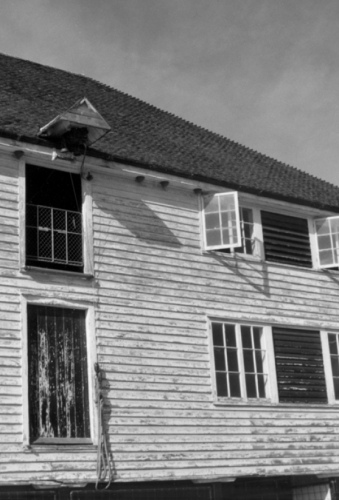
Copyright © 2004 the Brewery History Society
|
Journal Home > Archive > Issue Contents > Brew. Hist., 113, pp. 33-38 |
The Organics of Beer |
The first two weeks of September is the time for the harvesting of the hop crop. During this short period it was traditional that brewers would go on a ‘hop walk’, which entailed being driven around selected hop gardens on a straw bailed trailer behind a tractor. Afterwards a few noggins of ale were consumed! With a recent decline in the number of breweries, this old custom is dying out. However, a revival was instituted in I998, not only in the sense of this traditional gathering but also that a true organic hop was harvested and processed under the eyes of the brewers and some media.
Peter Hall is the fourth generation of his family to farm at Target Farm and Little Mill Farm, Marden, Kent, where an unspoilt double square kilned oast house previously serviced fifty acres of hops. Today these farms have been almost exclusively turned over to organic farming, including both apple and pear orchards. The entire estate has been sympathetically reverted back to a managed nature reserve and conservation business. This has entailed the clearing of two ponds which now have an enviable wild life habitat. Hedgerows linking copses, some twelve feet high forming wind breaks, are mulched with the humus from the hop bine debris. Peter Hall's enthusiasm for his wild-life friendly business is infectious.
Up until the I980s, HE Hall & Sons Ltd had some fifty acres (20 hectares) of hop gardens under cultivation. Several of the last years suffered severely from Downy Mildew, usually so active in warm weather, to the extent that several years there was no crop at all, The Oast house, erected in 1896 at Little Mill Farm, was built to serve this large acreage, and this now only services two and a hall acres, but very special acres they are.
Wye Target hops are organically grown and are used exclusively by the Caledonian Brewery, Edinburgh, for the UK's first vegetarian and organic beer, Golden Promise. This was launched in 1991 and was accredited by the Soil association and received its award for beverages in 1993 and 1996. Caledonian now bottle for the CO-OP a 5% Vol ‘Organic Premium Ale’, which has the Organic Certification UK5.
In 1998 the weather was ideal for organic hop production, as the spring came relatively late. The hop hills were ‘dressed’ in late March and by May there were fine bines. During this intervening period, one of the secrets of organic cultivation was implemented, the sowing of white mustard between each line of hop hills. This held a large population of predators - predominately our favourite bug the Ladybird, and also Lacewings. These had been in refuge in upturned plastic bottles lined with corrugated cardboard, fixed one to the top of each wooden post for the horizontal straining wires. The hops were trained up the four strings, fixed in the ground by a metal loop with the string tied to the top straining wires. The still conditions in late May ensured that the hop bines swiftly climbed the strings.
|
|
 |
|
|
During the cool and wet June, the Damson Hop Aphid moved in from the hedgerows and began to colonize the upper reaches of the bines. At the end of June, a single soap spray was applied in the rain to ensure that maximum penetration was made into the pest population. This was very effective as it killed off 95% of the unwanted ‘guests’, with the predators which by now also included Hoverfly larvae and Parasitic Wasps, which disposed of the remaining 5%. The other very destructive pest of the hop plant is the Two Spotted Spider Mite, which dislikes cool wet weather which was very evident in I998; thus it was conspicuous by its almost absence. Downey Mildew, which is usually so active in warm temperatures, was controlled by hand ‘rogueing’ and four sprays of copper oxychloride - the only approved fungicide for this disease. In late July the sun finally appeared and it became apparent that the 1998 harvest was likely to be a bumper crop. The hops continued to swell and the absence of pests and diseases allowed the harvest to be delayed to the week commencing 14th September. This later harvesting allowed the hops to develop to their maximum aroma.
Two tractors pulling specially designed trailers performed a shuttle service from the hop garden across the road from the Oast house. A further tractor with adapted hydraulic hoist, incorporating two platforms from which the ‘cutters’ operated, preceded the two carrier tractors. Up to I960, this job had been performed by skilled men on stilts. The picking process entailed all the bases of the hop bines being cut first, so that the cutting tractor and trailers proceed down between two lines of bines. The collecting tractor and trailer follows closely behind the cutters and deposit the bines into the trailer.
At the Oast house, which is a timber framed and red brick building built in I896, the hop trailer drives in at one end and deposits its load of hops onto the floor near the entrance; it then drives through and returns to the fields for its next load. The long bines are picked up off the floor by two men who fix the bines onto stout hooks on a continuous conveyor. This takes the full bines up into the first part of a long machine which stretches almost the full length of the Oast House (13 meters). A threshing motion strips off the hop bracts which drop down onto a flat conveyor belt, whilst the stripped bines pass through a shredder and are ejected out into the yard to form a compost heap. The hop bracts are riddled to remove damaged and other debris before being bagged.
Ten people are employed in the season working on the ground floor stripping operation, which ensures that only clean full hops are sacked. These small bags of fresh green hops are then taken up to the first floor and laid out onto the woven horse hair mat above the plenum heating chamber in one or both of the drying kilns. These are heated by diesel engines with large fans, situated at the rear, access being via a. narrow brick tunnel between the two kilns. This area was formerly the coal stoking area. When sufficiently dry, the hops are ‘scuppered’ (with a canvas lined shovel) onto the main upper floor. They are then spread out covering the entire floor area and gradually pushed towards the electric hop pocket filling machine. The one in use at Little Mill Farm was made by Weeks & Son of Maidstone.
The filling machine is mounted over a square hole in which there is a broad strap suspended below; on this rests the hop pocket. At the top of the hole, level with the first floor level, a metal ring expertly inserted into the top of the pocket then allows the hops to be scuppered into the sack. During the filling process, the hops are given a push-down several times until when nearly full, the press is brought into action. This skilled work is carried out by the only fully employed man at Little Mill Farm on hops, and his skill is to ensure that the considerable pressure from the press does not split the bag, but also fills it carried out by the only fully employed man at Little Mill Farm on hops, and his skill is to ensure that the considerable pressure from the press does not split the bag, but also fills it to the top. The press has a piston like ram action with a circular wood plate that engages into the top of the pocket through the metal ring. When the pocket is full the bag is sown up; only then can the strong canvas strap supporting it be removed on one side to allow the pocket to fall to the floor below to be stored. The Wye Target harvest of 1998 yielded an excellent 40 zentners from the 2.5 acre garden of Grade One hops.
|
|
 |
|
|
|
|
 |
|
|
Beside the comparatively new electric hoist in the small lucarne in the centre of the building, is a record board of previous harvests from the 50 acres. It is significant to note that the first entry in 1961 recorded 153 pockets, whilst ten years later, I97I had a bumper harvest of 536. The average number of pockets was noted to be about 390. Up in the roof timbers close by the lucarne door, still remains the original hand operated wooden wheel and winding drum. This eight fine spoked wheel is about five feet in diameter and has metal ‘V’ around its outer edge at about twelve inches apart; this is to retain the hand pulling rope around the wheel rim. The attached drum still has the metal chain once used to raise and lower the sacks of hops into the top floor. All this operation is now carried out by an electric motor in the small lucarne at gutter height, just below the eaves. Peter Hall has installed several plastic Housemartin nest boxes to encourage these delightful birds; another expression of his care for the countryside.
There are at least two Regional brewers who have an organic beer within their ranges. Sam Smith of Tadcaster, Yorkshire, and the Caledonian Brewing Company Ltd of Edinburgh; both weigh in at 5% abv and have a similar lovely golden colour and moorish flavour, and have the Organic Certification, UK5. In 500m1 and 550m1 bottled form, both have eye-catching labels, with Sam Smiths using a lovely ‘old-style’uo, red cream and black label incorporating their 1998 Gold Medal; the beer is called ‘Organic Best Ale’. Caledonian use their specially designed half-round topped label with a large golden wheatsheaf, supported by two open pockets of hops; this is ‘Golden Promise’. Organically grown Scottish barley is malted in the Highlands and is cleared by filtration. Chariot barley is malted by Baird's at the Pentcatland maltings south of Edinburgh. An organic beer imported from Germany and sold by the Waitrose Supermarket, is Brauerei Pinkus Müller,in Munster. This too is a 5% abv made with organically grown barleymalt and wheatmalt. The back label also continues the theme of ‘purity’ by stating that all the packaging is re-cycled and that the paper label and inks are chemical-free. This small home-brew tavern has been on the same site since 1816 and is renowned throughout Germany for its organic beer range. Hallertau hops are used in this first certified ‘all organic’ brewery, and the appellation of ‘Bioland’ signifies that production is licensed under the European Commission Regulation (EEC) No 2092/92I, and that Bioland is an approved body under the International Federation of Organic Agricultural Movements (IFOAM). You might as well get used to this EEC jargon, there's more to come! Clearly the ‘green message’ is spreading to our beer.